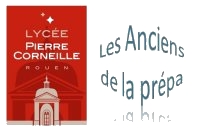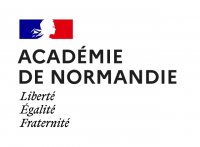The Lycée Corneille of Rouen
A FEW LANDMARKS IN THE LIFE OF A 400-YEAR-OLD LYCEE.
When in the second half of the 16 th century the Reformation swept through France, weakening the influence of the Catholic Church, the then Cardinal Archbishop of Rouen, Charles de Bourbon, the King’s cousin, wished to create a school that would be instrumental in moulding the children of the aristocracy and bourgeoisie in accordance with the purest doctrinal principles of Roman Catholicism. He entrusted this task to the newly-created order of Jesuits, and in 1593, the Collège de Bourbon first opened.
17 th Century :
This enterprise immediately achieved remarkable success. By 1662, the lycée could boast two thousand pupils.
To the first of a series of enlargements then decided we owe the present day gate house and the chapel (built from 1614 to 1631) whose original style fuses the gothic and classical traditions. Lectures were given in Latin, the language the students were made to speak to one another. Latin took centre-stage, and French, History, Geography and Science were deemed of less importance. The number of classes were few, as the school barely counted ten teachers.
18 th Century :
The school curriculum very gradually gave more importance to Science.
The buildings, ill-assorted and antiquated, were replaced by new ones in a bold effort to rebuild the whole school. The Salle des Actes, and the somewhat austere buildings surrounding the main square and the yard known as the ‘kitchen yard’ bear witness to that building programme. The Clock and its Motto : Hic labor, hic requies Musarum pendet ab horis , is the motto carved around the face of our clock, it translates as follows : in this place, work or the repose of the Muses hang on the passing of hours. When in 1762 the Jesuits were expelled from France, the school became known as the ‘Collège Royal’ and was run along much the same lines as before.
The French Revolution and Empire.
In 1796, the Collège Royal gave way to the ‘ Ecole Centrale’ , which, influenced by the educational theories of the Age of Enlightenment, departed from the systematic study of Humanities, and promoted a broader-based curriculum.
In 1803, the lycée, soon to become known as the ‘Lycée Impérial , was created, and the opportunity seized to return to the study of Humanities and mathematics.
19 th Century :
The Lycée was run in accordance with the principles laid out by the Napoleonic system, many students were boarders, everyone wore uniform, and the harsh discipline enforced led to many ‘rags’, which occasionally developed into full-blown rebellions.
The baccalaureate marked the successful completion of a course of studies, and though the curriculum remained classical, languages and Natural Sciences were by now beginning to assert themselves. The Classes préparatoires (i.e. extremely demanding two-year post baccalaureate classes for students wishing to sit the competitive entrance examinations to our Grandes Ecoles, i.e. the best higher education establishments the country has to offer ) were created in 1870. In 1873, the Lycée finally became known as the Lycée Corneille ,and at the same time, a ‘ petit lycée’ was built along the rue de Joyeuse, north of the main building, to cater for the needs of younger primary school pupils. In 1890, Les Francs Joueurs, a sports club was founded, evincing new educational concerns.
20 th Century :
A Norwegian section was founded in 1918 ; it still exists, and has welcomed since an average of twenty-four boys who spend three years at the lycée.
The school became a military hospital during the first World War. Part was commandeered by the German army of occupation in the Second World War, when it was bombed twice, once in September 1942, and more seriously on April 19 th , 1944. In 1958, a cinematographic class was founded, and in 1993, a post-baccalaureate two-year course was added, enabling students to take a BTS diploma.. The lycée has conformed to the evolution of the French educational system. First, the primary school was done away with, then, later, the boys’ school was turned into a co-educational institution, which concentrated on older pupils, 5 th- and 6 th - formers only (1971). The number of boarders fell, and Sciences grew more and more important in the training of pupils. At that period, many other schools were built.
21 st Century :
Nowadays, with approximately one thousand-six-hundred pupils, one third of whom are post-baccalaureate students, the Lycée Corneille remains a prestigious establishment, as the pass-rates clearly testify, both at baccalaureate and post-baccalaureate levels.
The Conseil Régional de Haute Normandie, the responsible local authority, is currently studying a restructuring programme for the school which will make provision for the old buildings to be completely refurbished.
Additional Information :
The Chapel : The foundation stone was laid by King Henri IV’s widow, Marie de Médicis, in 1614. It was first used in 1631. It is a fifty-two-metre-long cross-shaped building with one nave, a combination of late gothic and classical architecture. Due to lack of maintenance, it became very dilapidated and was almost pulled down when the Conseil Municipal decided to save it in 1895. It became a listed building in 1908.
Since 1959, work on the building has never ceased, making it possible for services and cultural activities to be held there. At present, it is closed to the public because of further restoration work.
Old Boys.
Apart from Pierre Corneille, the lycée can claim many famous writers and men of distinction among its old boys (Fontenelle, Bernardin de St Pierre, Flaubert, Maupassant, Maurice Leblanc, André Maurois among others), painters (Delacroix, Corot, J. Villon) scientists (Charles Nicolle, Pierre-Louis Dulong, Descroizille, Emile Blondel) and a host of ministers, MPs, generals, industrialists, jurists, physicians, artists and teachers...
From 1840 onwards, Parisian old-boys have organised an annual dinner ; and in 1864, the Association des Anciens Elèves was founded with a view to helping its younger members and fostering their camaraderie. ‘ Notre Vieux Lycée’ , their magazine, was first published in 1906. The War memorial inside the school lists the names of the many former pupils who fell during the two World Wars or died in concentration camps. A ceremony of commemoration is held there annually on Remembrance Day.









